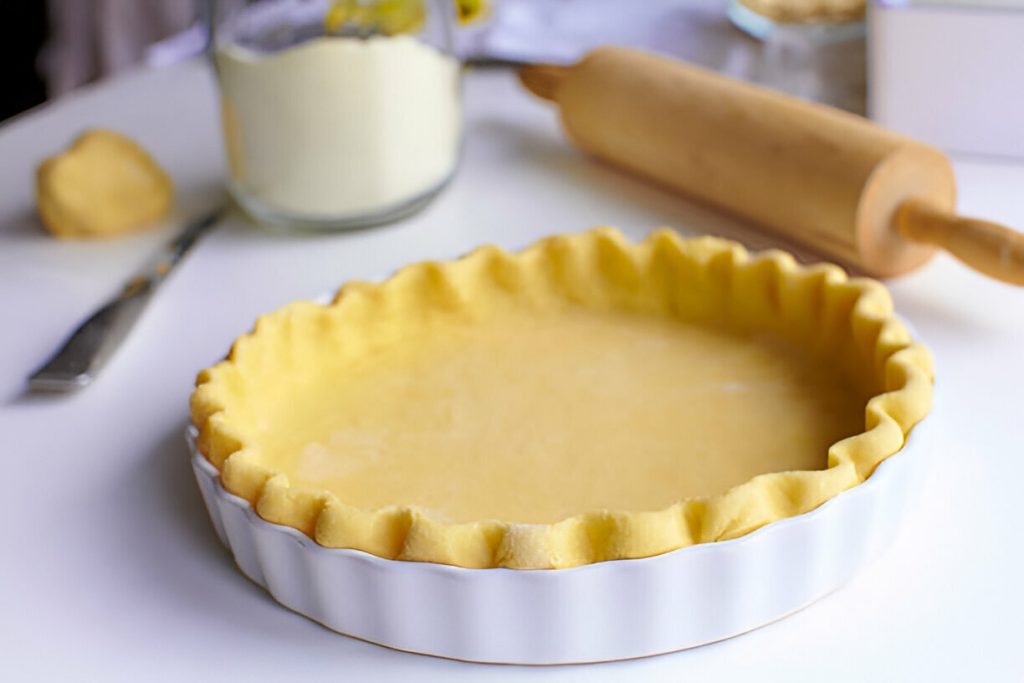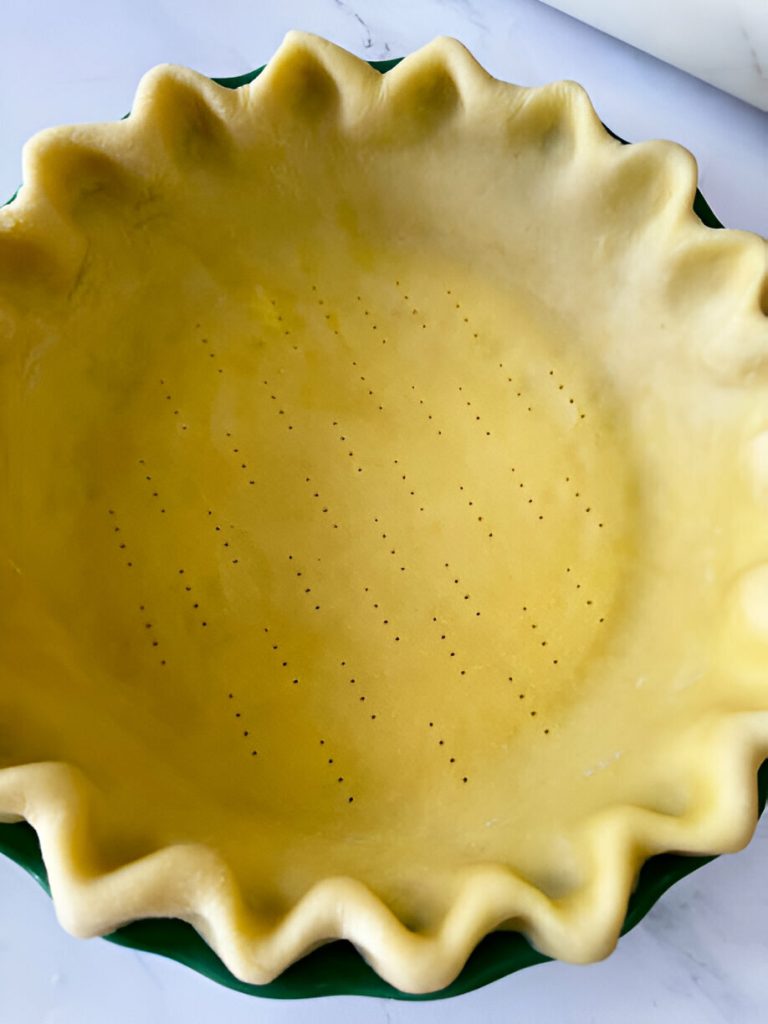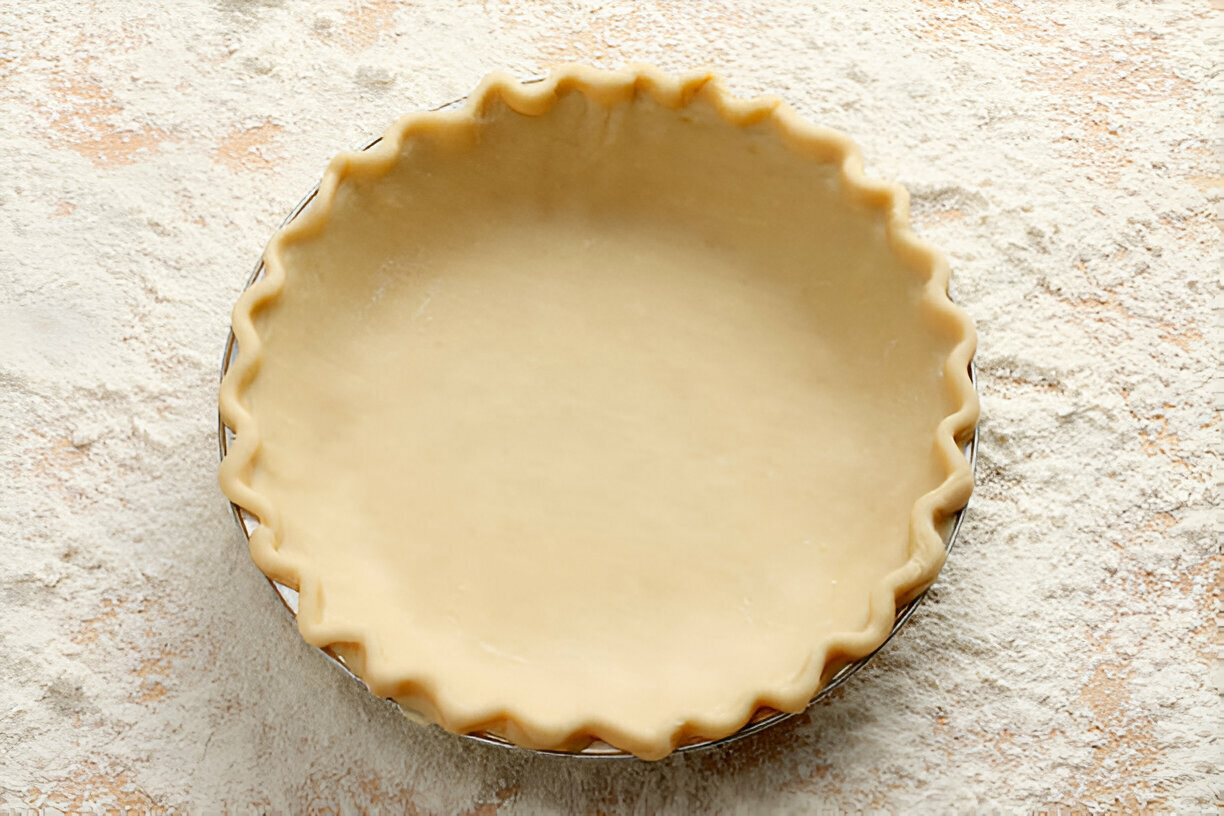Easy Pie Dough Crust Recipe
A good pie crust is the foundation of any exceptional pie, and this recipe delivers consistent, flaky results every time. Its versatility makes it an indispensable choice for both sweet and savory creations, ensuring your pies always turn out perfectly.

Ingredients Breakdown
The ingredients in this pie dough recipe are thoughtfully selected to achieve an ideal balance of flavor and texture. All-purpose flour provides structure, while the combination of sugar and salt enhances the taste, balancing sweetness and savoriness.
Butter plays a starring role, creating the flaky layers that make a crust irresistible. For the best results, use unsalted butter and ensure it’s cold before incorporating it into the dough. Cold water is equally essential, helping the dough bind together without activating too much gluten, which keeps the crust tender. For seasoning, Diamond Crystal kosher salt is recommended, but table salt can also be used with slight adjustments in measurement.
Step-by-Step Preparation Guide
Start by combining two-thirds of the flour with sugar and salt in a food processor. This ensures even distribution of the dry ingredients before adding the butter. The butter should be sliced into uniform 1/4-inch pieces and evenly spread over the flour mixture. Pulse until the butter and flour form clumps, creating a coarse, sandy consistency. Add the remaining flour and pulse briefly to create a slightly crumbly texture.
Transfer the mixture to a bowl, drizzle cold water evenly over the top, and gently fold the dough with a rubber spatula. Press and fold the dough just enough to bring it together without overworking it. Divide the dough into two equal portions, shaping each into a 4-inch disk. Wrap them tightly in plastic wrap and refrigerate for at least two hours. Chilling the dough is crucial for firming the butter and preventing shrinkage during baking.
Rolling and Shaping the Dough
When it’s time to roll out the dough, work on a well-floured surface to prevent sticking. Begin rolling from the center outward, rotating the dough frequently to maintain an even thickness and circular shape. The finished dough should extend 1 to 2 inches beyond the size of your pie plate.
To transfer the dough, roll it carefully around your rolling pin, then unroll it over the pie plate. Fit the dough snugly into the corners of the plate without stretching it, as stretching can cause the crust to shrink during baking.
For a single-crust pie, trim the dough to a 1/2-inch overhang, then tuck and flute the edges for a polished look. For a double-crust pie, follow the same process, adding the top crust after filling the pie. Seal the edges by pinching them together and create vent holes in the top crust with a sharp knife to allow steam to escape.

Recipe Tips
Chill the dough thoroughly before rolling to prevent shrinkage during baking.
Add a touch of cinnamon or herbs to the dough for a flavor boost tailored to your pie filling.
Use parchment paper or a silicone mat when rolling the dough for an easy cleanup and seamless transfer to the pie plate.
What to Serve With This Recipe
This pie dough pairs beautifully with a variety of sweet fillings such as classic apple, cherry, or pumpkin. For savory options, consider hearty chicken pot pie or a rich quiche. Serve with sides like freshly whipped cream for dessert pies or a crisp green salad to complement savory pies.
Frequently Asked Questions
How do I prevent my dough from becoming too tough?
Avoid overmixing or overhandling the dough, which can activate gluten and result in a tougher crust.
Can this dough be made ahead and frozen?
Yes, wrap it tightly in plastic and freeze for up to three months. Thaw overnight in the refrigerator before use.
Is it possible to use a food processor alternative for mixing?
Yes, you can use a pastry cutter or your hands to mix the butter into the flour manually.
What should I do if my dough tears while rolling or transferring?
Patch tears with small pieces of extra dough, pressing gently to seal.
To finish your pie, consider decorative edges or lattice patterns for a stunning presentation. Brushing the crust with an egg wash and sprinkling with sugar creates a golden, glossy finish for sweet pies. For savory pies, an egg wash alone will suffice. Blind-baking is recommended for fillings that require less baking time than the crust, ensuring your crust remains crisp and avoids becoming soggy. With this versatile dough, you’re set to create a pie that’s as delicious as it is beautiful.

Ingredients
2 3/4 cups (12.5 ounces; 350g) all-purpose flour, divided
2 1/2 sticks (10 ounces; 280g) unsalted butter, cut into 1/4-inch-thick slices (see note)
6 tablespoons (3 ounces; 85ml) cold water
2 tablespoons (25g) sugar
1 1/2 teaspoons (5g) Diamond Crystal kosher salt; for table salt, use same weight or half as much by volume
Instructions
Combine two-thirds of the flour with sugar and salt in a food processor. Pulse a couple of times to mix. Evenly distribute the butter slices over the surface of the flour mixture. Pulse until the dry flour is fully incorporated, and the mixture starts forming clumps, which should take about 25 short pulses. Use a rubber spatula to scrape down the bowl and spread the dough evenly. Add the remaining flour and pulse again, about 5 short bursts, until the dough is just starting to break apart. Transfer the mixture to a large bowl.
Drizzle the cold water over the dough mixture. Use a rubber spatula to fold and press the dough until it comes together into a cohesive ball. Divide the dough into two equal portions. Shape each portion into a 4-inch disk, wrap them tightly in plastic wrap, and refrigerate for a minimum of 2 hours to chill before rolling and baking.
When ready to roll out the dough, place one disk on a well-floured surface. Dust the dough and rolling pin with flour to prevent sticking. Use a tapered rolling pin to roll the dough into a circular shape, rotating and lifting it frequently to maintain an even thickness and shape. Roll until the dough extends 1 to 2 inches beyond the size of your pie plate.
To transfer the dough, gently roll it around the rolling pin, using a bench scraper if needed to lift it from the work surface. Carefully unroll the dough over the pie plate. Fit the dough into the plate, making sure it settles into the corners without stretching.
For a single-crust pie, trim the dough using kitchen scissors so it overhangs the plate by 1/2 inch. For a double-crust pie, fill the pie at this stage, then place the second round of dough over the filling. Trim both layers of dough to a 1/2-inch overhang. Tuck the overhanging edges under themselves all around the pie plate.
To create a decorative edge, flute the crust by pinching it with the thumb and forefinger of one hand against the forefinger of the other hand. If making a single-crust pie, the shell is now ready for blind-baking or filling. For a double-crusted pie, brush the top crust with egg white, sprinkle with sugar, and cut vent holes using a sharp knife before baking.

Easy Pie Dough Crust Recipe
Ingredients
- 2 3/4 cups 12.5 ounces; 350g all-purpose flour, divided
- 2 1/2 sticks 10 ounces; 280g unsalted butter, cut into 1/4-inch-thick slices (see note)
- 6 tablespoons 3 ounces; 85ml cold water
- 2 tablespoons 25g sugar
- 1 1/2 teaspoons 5g Diamond Crystal kosher salt; for table salt, use same weight or half as much by volume
Instructions
- Combine two-thirds of the flour with sugar and salt in a food processor. Pulse a couple of times to mix. Evenly distribute the butter slices over the surface of the flour mixture. Pulse until the dry flour is fully incorporated, and the mixture starts forming clumps, which should take about 25 short pulses. Use a rubber spatula to scrape down the bowl and spread the dough evenly. Add the remaining flour and pulse again, about 5 short bursts, until the dough is just starting to break apart. Transfer the mixture to a large bowl.
- Drizzle the cold water over the dough mixture. Use a rubber spatula to fold and press the dough until it comes together into a cohesive ball. Divide the dough into two equal portions. Shape each portion into a 4-inch disk, wrap them tightly in plastic wrap, and refrigerate for a minimum of 2 hours to chill before rolling and baking.
- When ready to roll out the dough, place one disk on a well-floured surface. Dust the dough and rolling pin with flour to prevent sticking. Use a tapered rolling pin to roll the dough into a circular shape, rotating and lifting it frequently to maintain an even thickness and shape. Roll until the dough extends 1 to 2 inches beyond the size of your pie plate.
- To transfer the dough, gently roll it around the rolling pin, using a bench scraper if needed to lift it from the work surface. Carefully unroll the dough over the pie plate. Fit the dough into the plate, making sure it settles into the corners without stretching.
- For a single-crust pie, trim the dough using kitchen scissors so it overhangs the plate by 1/2 inch. For a double-crust pie, fill the pie at this stage, then place the second round of dough over the filling. Trim both layers of dough to a 1/2-inch overhang. Tuck the overhanging edges under themselves all around the pie plate.
- To create a decorative edge, flute the crust by pinching it with the thumb and forefinger of one hand against the forefinger of the other hand. If making a single-crust pie, the shell is now ready for blind-baking or filling. For a double-crusted pie, brush the top crust with egg white, sprinkle with sugar, and cut vent holes using a sharp knife before baking.

